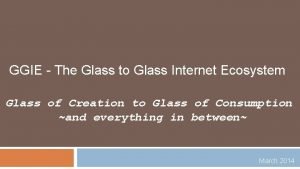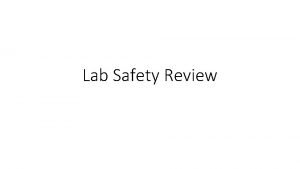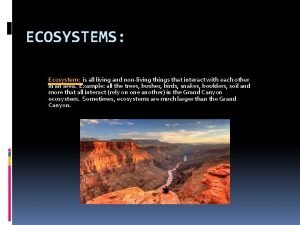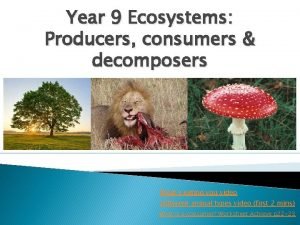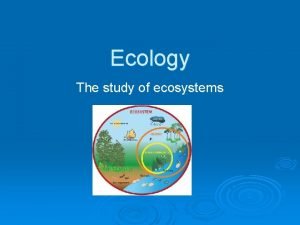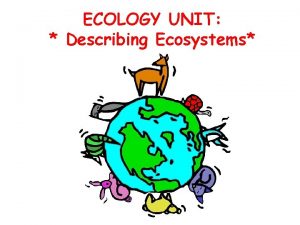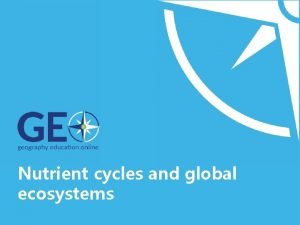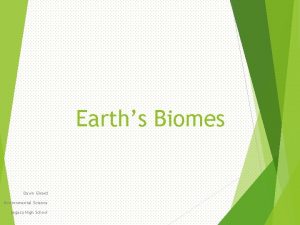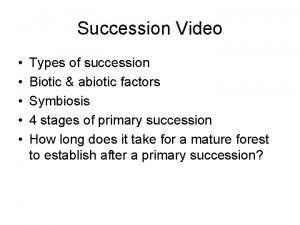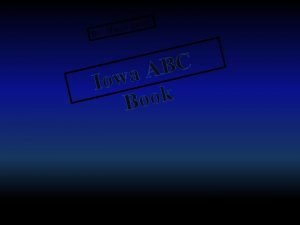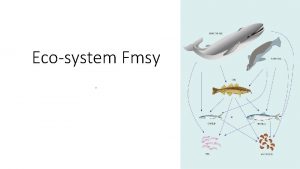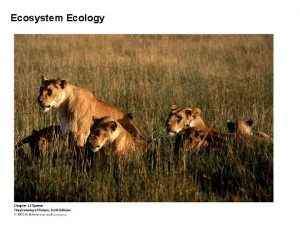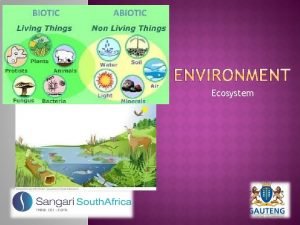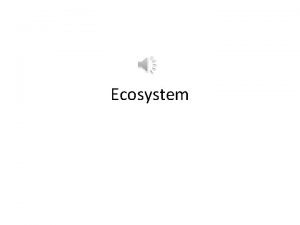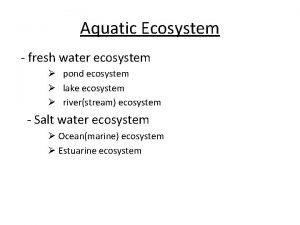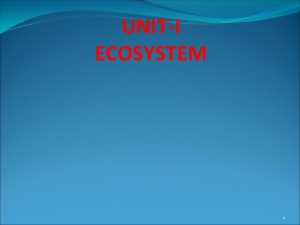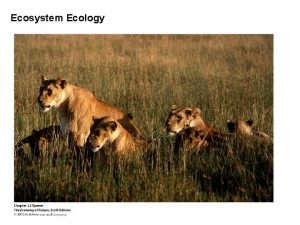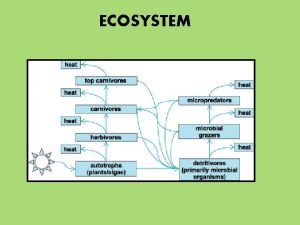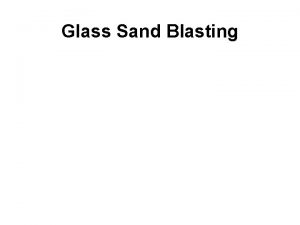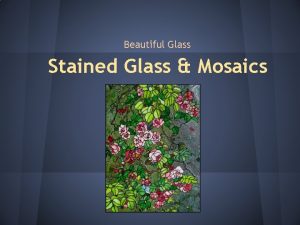GGIE Glass to Glass Internet Ecosystem Glass of














- Slides: 14

GGIE Glass to Glass Internet Ecosystem (Glass of Creation to Glass of Viewing) Oct 27, 2014 Glenn Deen – glenn. deen@nbcuni. com

Trends Behind This Idea • Digital video is dependent on many orgs and their parts of the glass to glass ecosystem –W 3 C, IETF, SMPTE, CEA, MPEG, IEEE, ATSC +Consortia (EIDR) and companies +Each focuses on their scope and hope that others are seeing the same big-picture -> liaisons help coordinate, but it’s slow and piecemeal • Digital content is reaching a scaling wall where simply adding new capacity to the Internet isn’t enough to meet continuing growth –Growth in # of users –Growth in # of devices –Growth in # of markets –Growth in bandwidth and low-latency requirements • Cross-Migration of professional tools and abilities to personal video makers –Cameras, Editing Tools, Asset Management, Streaming Services, Displays –Hard to tell well done amateur content from professional work

Content Delivery is getting much more Complex Television Circa 1994 IR IR Remote Control Composite Component Coax NTSC, NTSC-J, PAL, SECAM VCR OTT Television Circa 2014 Internet IR/RF Remote Control Ethernet Wi-Fi HDMI Wi-Fi S/PDIF Modem Router/AP OTT STB/Dongle

Standards Circa 1994 Connectivity • Component: EIA-770. 1 (analog NTSC typically using 3 wires - YPBPR) • Composite: EIA/RS-170 A (analog baseband NTSC composite video) • Coax: 75 ohm modulated RF NTSC • Remote Control: IR - Proprietary Encoding • NTSC: Broadcast standard for analog TV • NTSC-J: Broadcast standards for analog TV in Japan • PAL: Broadcast standard for analog 625 line/50 Hz systems used in most of Europe and parts of Asia, South America and elsewhere • SECAM: Broadcast standards for analog TV originating in France but used in other areas as well.

A Few of Standards Circa 2014 Connectivity • HDMI: CEA 861 -F • CEC (Consumer Electronics Control) • ARC (Audio Return Channel) • HEC (HDMI Ethernet Channel • HDCP: High Definition Content Protection (over HDMI) • Wi-Fi: IEEE 802. 11 a/b/g/n/e… • Ethernet: IEEE 802. 3 • S/PIDF (Optical Port): IEC 60958 type II • Remote Control • IR: RC-5/6 (Philips); NEC; proprietary • RF: RF 4 CE (Zig. Bee), Bluetooth LE; low power Wi-Fi Video Codecs • MPEG-1: ISO/IEC 11172 • MPEG-2: H. 262 (used by ATSC digital broadcast) • MPEG-4: H. 264 • HEVC: H. 265 • WMV 3 • VC-1 • Flash Others • CEA-708 B: Closed Captioning • TTML 10 (W 3 C): Closed Captioning Network & Transport � IPv 4/IPv 6 � IP Multicast � TCP � UDP � HTTP/HTTPS � HTML � HTTP progressive download � MPEG Dash/CFF � HLS streaming Apple) � Smooth Streaming (Microsoft) � HDS steaming (Adobe) � RCSP • MP 3 • MP 2 • AAC • AC-3 (Dolby Digital) • Dolby True. HD • DTS • EIDR � Div. X Plus Streaming technology � ASF � MPEG-2 TS � MPEG 2 -PS � HTML 5 � RTSP � RTCP � RTP � TLS � Web. RTC +DLNA � UPn. P Audio Codecs Content Identification

Exploding Video Data 8 k Ultra-HDTV 4 k Ultra-HDTV 3840 x 2160 60 fps 20 -40 Mbps HDTV 1280 x 720 60 fps 2 -4 Mbps 7680 x 4320 120 fps? 80 -200 Mbps Full HDTV 1920 x 1080 30 fps 4 -8 Mbps Today QVGA 320 x 240 10 -15 fps 500 kbps VGA/SDTV 640 x 480 30 fps 1 -2 Mbps SD -> HD -> 4 K -> 8 K 4 x 4 x 4 = 256 x

Houston, We Have a Scaling Problem • Digital Video growth consumes all new bandwidth thrown at it –And will likely continue to do so for years to come • Each jump in resolution is a 4 X jump data –SD x 4 = HD x 4 = 4 K x 4 = 8 K = 256 x today’s SD – 4 K expected to add more color and HDR • Constant growth of new devices – 2009 OTT video – 1 PC per home watching compressed SD --> Depending on how you do the math we might be behind by 256 x-1024 x – 2014 OTT video – 4, 5, more evenusers) 6 devices per home (and don’t forget adding 200%

Example Use Case #1 Edge Device Selects best source for digital content delivery Elements: –Device identifies the digital content it is playing via any of 1. Container metadata 2. Imbedded Content ID in content watermark 3. fingerprint match of the content & lookup of Content ID –Device uses Content ID to locate sources which can provide the content –Content Distribution Services advertise Content IDs for content they offer –Device dynamically selects the source to obtain the content from GAP Issues: –Identifying the device to the service –Authorizing the device & service –Migrating access across distributed services

Example Use Case #2 Edge Device offers content to other devices (edge device-device delivery) Elements –A device holds content identified by a Content ID –Device advertises the Content ID for content that it offers to other devices • Well defined URI name space for advertising availability GAP Issues: –Different Codec / Resolution Requirements –What to do when the device doesn’t hold some segments that are needed. –Privacy –Device-Device identification/authorizations

High Level Goal Help Improve the state of the art in open standards for both professional and nonprofessional digital video focusing on all phases of the digital video life cycle: Find-Watch Capture-Edit-Package-Distribute- Not an new SDO! Focus is on identifying work for existing SDO’s Standards • Possible examples:

What’s in scope & out In Scope: • All content levels: Personal – Prosumer – Professional • GGIE will look from Glass to Glass – whole ecosystem not just the Web • Content Workflows: Capture, Edit, Distribute, Discover, View • Focus Areas: Scalability, Content Identification, Metadata, User Identity, Privacy Out of Scope • Non-Internet Delivery (discs/drives/Flash memory/OTA/Cable) • Codecs/Encoding selection & development • Encryption specification (whether for protection or privacy) • Legal Topics

GGIE Outputs Use Cases & GAP analysis of missing elements by SDO’s Interested parties then take the outputs to SDOs and address missing features W 3 C, IETF, SMPTE, IEEE, CEA – wherever the missing element fits best Potential Examples: Use case features a device identifying the content it is playing back and the edge device making smart access choices GAP Results: 1. Need an API that would allow an application to identify the playing content – could extract from the content container, from the content via watermark or via fingerprint 2. Need a standardized URN to refer to an digital content asset 3. Need standardized name spaces and content identifiers registries

GGIE Current Status • Supporters who see it as valuable and want to contribute • Organized F 2 F – London March 2014 at end of IETF 89 • Web. Ex meetings • Mailing list hosted by ISOC GGIE needs an organizational home such as W 3 C –Enable participants to work together –Provide legal framework & IP rules –Creating a new org would be painful and expensive

Next Step? Contact Info: Glenn. Deen@NBCUNI. COM
 Ecosystem
Ecosystem Internet or internet
Internet or internet True or false hot glass looks the same as cold glass.
True or false hot glass looks the same as cold glass. Does hot glass look like cold glass
Does hot glass look like cold glass What is the glass escalator
What is the glass escalator Tropical rainforest living and nonliving things
Tropical rainforest living and nonliving things Decomposers
Decomposers Ecosystem level of organization
Ecosystem level of organization Energy role
Energy role Ecosystems examples
Ecosystems examples What is a ecosystem
What is a ecosystem Which phrase best describes an ecosystem?
Which phrase best describes an ecosystem? Gersmehl diagram
Gersmehl diagram Grassland ecosystem
Grassland ecosystem Abiotic types
Abiotic types
